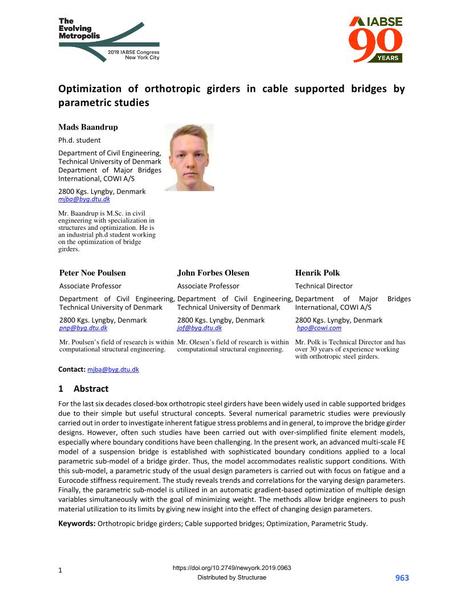Optimization of orthotropic girders in cable supported bridges by parametric studies

|
|
|||||||||||
Bibliographic Details
| Author(s): |
Mads Baandrup
Peter Noe Poulsen (Department of Civil Engineering, Technical University of Denmark) John Forbes Olesen (Department of Civil Engineering, Technical University of Denmark) Henrik Polk (Department of Major Bridges International, COWI A/S) |
||||
|---|---|---|---|---|---|
| Medium: | conference paper | ||||
| Language(s): | English | ||||
| Conference: | IABSE Congress: The Evolving Metropolis, New York, NY, USA, 4-6 September 2019 | ||||
| Published in: | The Evolving Metropolis | ||||
|
|||||
| Page(s): | 963-968 | ||||
| Total no. of pages: | 6 | ||||
| DOI: | 10.2749/newyork.2019.0963 | ||||
| Abstract: |
For the last six decades closed-box orthotropic steel girders have been widely used in cable supported bridges due to their simple but useful structural concepts. Several numerical parametric studies were previously carried out in order to investigate inherent fatigue stress problems and in general, to improve the bridge girder designs. However, often such studies have been carried out with over-simplified finite element models, especially where boundary conditions have been challenging. In the present work, an advanced multi-scale FE model of a suspension bridge is established with sophisticated boundary conditions applied to a local parametric sub-model of a bridge girder. Thus, the model accommodates realistic support conditions. With this sub-model, a parametric study of the usual design parameters is carried out with focus on fatigue and a Eurocode stiffness requirement. The study reveals trends and correlations for the varying design parameters. Finally, the parametric sub-model is utilized in an automatic gradient-based optimization of multiple design variables simultaneously with the goal of minimizing weight. The methods allow bridge engineers to push material utilization to its limits by giving new insight into the effect of changing design parameters. |
||||
| Keywords: |
optimization parametric study cable-supported bridges Orthotropic bridge girders
|
||||
